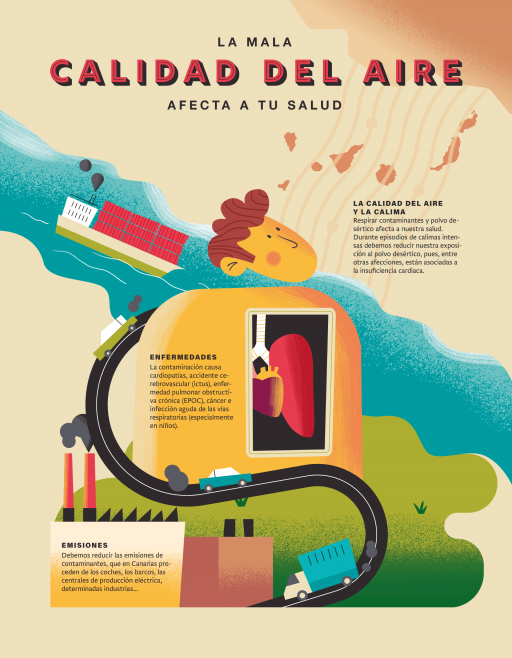Soot and haze are taking their toll on the hearts of the Canary Islanders
IPNA-CSIC is studying the composition of the atmosphere and air quality in the Islands and its implication for the health of their inhabitants.
The Urban soot and haze are the substances that have the greatest impact on the health of the Canary people. On the one hand, poor air quality affects the health of the planet and its inhabitants, who now face the challenge of reducing pollutant emissions to protect the health of humans and ecosystems. But in the case of the Canary Islands, the challenge goes further. In addition to the pollutants emitted by our cars, ships and electric power stations, the islands are exposed to uncontrollable desert dust from the Sahara.
Air pollution is responsible for some seven million deaths a year worldwide. There are many health problems associated with breathing the cocktail of pollutants floating in the ambient air. In particular, suspended particles in the air have been blamed especially for adverse health effects as they make their way to the deepest reaches of our lungs. In urban areas the particles are often very fine, many of them less than 0.1 µm (1/10 micron = a ten thousandth of a mm). These infinitesimal particles contain soot from diesel vehicles, ultrafine material and sulphur, which comes from cars, ships and power plants, and previously also from the refinery in Santa Cruz. These particles enter the body through the respiratory tract and reach the alveoli, the deepest part of our lungs, where they cause inflammation and thereby sometimes make their way into the bloodstream.
Exposure to these pollutants is closely linked to heart damage. It has been shown that inhaling these particles can lead to the development of ischaemic heart disease and atherosclerosis, i.e. the narrowing of the artery around the heart that supplies it with oxygenated blood. In fact, it is estimated that around 40 % of deaths caused by pollution are due to this heart condition. But their potential effects do not stop there. When inhaled, these substances can also change course and reach the brain, for example causing strokes, or stay in the lungs and cause chronic obstructive lung disease.
Although traditionally considered natural, desert dust haze (calima) also affects our health. Unlike urban combustion pollutants (which are usually very small particles), desert dust particles are usually coarse, between 1 and 10 micra (or microns). Despite their size, these particles are also capable of entering the upper and middle parts of the respiratory tract, where they give rise to inflammatory processes that can also trigger cardio-respiratory diseases. Research carried out in Tenerife by the IPNA-CSIC and the University Hospital of the Canary Islands has shown that inhaling this dust suspension in the air increases the risk of death from cardiac arrest in people over 65.
The Institute of Natural Products and Agrobiology (IPNA-CSIC) is working to study the factors that induce poor air quality, since this affects the health of the population of the Canary Islands. The research line is led by Sergio Rodríguez, who has worked at the European Union's Climate Change Unit in Italy, and in various national and Canary Island research groups. He warns that to mitigate the effects of pollution on the health of the Canary Islanders, we must work in two directions: 1) reducing emissions of pollutants linked mainly to fossil fuel combustion, locally petrol and diesel; and 2) formulating action protocols and warnings to the population when there are intense episodes of Saharan dust haze. Local pollution can and must be reduced, but we will have to live with the haze and learn to defend ourselves against it.


